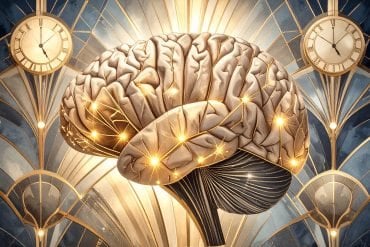Summary: Children who are physically active have higher cognitive function and increased functional connectivity in the brain later in life than those who are less active, a new study reports.
Source: Kobe University
A research group including Professor MATSUDA Tetsuya of Tamagawa University’s Brain Science Institute (Machida City, Tokyo; Director: SAKAGAMI Masamichi) and Assistant Professor ISHIHARA Toru from Kobe University’s Graduate School of Human Development and Environment has illuminated the changes in the brain’s neural network and cortex structure that underlie the positive association between childhood exercise and the maintenance and promotion of cognitive function in later life.
These results were published in the academic journal NeuroImage on May 23, 2021.
Main Points
- The researchers showed that people who are physically active during childhood (up to 12 years of age) have higher cognitive functions in later life.
- However, they could not find a correlation between cognitive function and post-childhood physical activity.
- The positive association between childhood exercise and cognitive function was evident in the modular (*1) segregation of brain networks, strengthened inter-hemispheric connectivity, greater cortical thickness, lower levels of dendritic arborization and decreased density.
- During childhood, the formation of the brain’s network is susceptible to environmental and experience-related factors. It is thought that exercise during this period optimizes brain network development and is linked to the maintenance and promotion of cognitive function in later life.
Research Background
Research over the previous decade has shown that exercise during childhood affects the development of cognitive functions. Recent findings have indicated that these benefits of childhood exercise extend to the maintenance and promotion of cognitive functions in middle age and later life.
However, the changes in brain functionality and structure related to this positive association have yet to be illuminated.
This research study investigated the relationship between physical activity in childhood and cognitive function in later life, using MRI (magnetic resonance imaging) to illuminate the structural and functional changes in the brain that are behind this relationship.
Experiment Method
The research group conducted a study on 214 participants ranging in age from 26 to 69 in order to investigate the relationship between childhood exercise and cognitive function, and the underlying functional and structural neural networks and cortical structure.
Childhood exercise was assessed via questionnaire. One aspect of cognitive function, response inhibition (the ability to suppress inappropriate behaviors), was measured using a Go/No-go task.
The image data from the MRI was analyzed and the following were calculated: structural and functional connectivity (*2), cortical thickness, myelination, the degree of neurite orientation dispersion and density index.
The brain was divided into 360 areas in accordance with the Human Connectome Project (*3), and functional and structural parameters were obtained for each area. In the statistical analysis, information obtained through the questionnaire was used as confounders.
This included each participant’s educational background, parents’ educational background, number of siblings and exercise during adulthood.
Experiment Results
Firstly, the researchers analyzed the relationship between whether participants exercised during childhood and Go/No-go task performance (false alarm rate). They found that participants who exercised during childhood (up until age 12) had a lower false alarm rate than those who didn’t.
Furthermore, this correlation was found regardless of the age of the participant. However, no such relationship was found between task performance and post-childhood exercise.
Next, the research group investigated structural and functional connectivity in the brain relating to Go/No-go task performance in participants who exercised during childhood.
From these results, they confirmed that in terms of structural connectivity in the brain, there were positive associations and negative associations between exercise during childhood and the false alarm rate in the Go/No-go task.
Large-scale network connectivity was found in over half (73%) of structurally connected areas that were positively associated with the Go/No-go task false alarm rate.
On the other hand, inter-hemispheric connectivity was found in the majority (88%) of structurally connected areas that were negatively associated with the task’s false alarm rate.

In terms of connections between functional areas, connections showing positive associations with the Go/No-go task false alarm rate were identified in participants who exercised during childhood but no negatively associated connections were found. Furthermore, large-scale network connectivity was found in the majority (91%) of connected areas that were positively associated with the task’s false alarm rate.
In those participants who did not exercise during childhood, there was no structural or functional connectivity identified in relation to the false alarm rate in the Go/No-go task. Lastly, the researchers investigated cortical structure parameters in relation to the Go/No-go false alarm rate for participants who exercised as children. They found that task performance was negatively associated with cortical density, and positively associated with the degree of neurite orientation dispersion and density.
The above results demonstrate that modular segregation and strengthened inter-hemispheric connections in the brain networks of people who exercised during childhood reduced the number of mistakes that they made in the Go/No-go task.
Glossary
1. Module: A single unit that combines with others to form the entire structure of a system. The human brain has a clear modular structure: it is divided into a number of large-scale networks made up of multiple areas.
2. Structural and Functional Connectivity: This refers to the structural and functional relationships between different areas of the brain. Structural connections between areas of the brain can be identified by anatomical nerve fiber connections, and functional connections are indicated by similarities in patterns of neural activity.
3. Human Connectome Project: This large scale research project began in North America in 2012 and aims to deepen understanding of brain connectivity.
Acknowledgements
Funding: This research received funding from the Ministry of Education, Culture, Sports, Science, and Technology of Japan (MEXT) research project ‘The science of personalized value development through adolescence: integration of brain, real-world, and life-course approaches’ (Scientific Research on Innovative Areas: Research in a proposed research area) and the Japan Agency for Medical Research and Development’s ‘Strategic Research Program for Brain Sciences’ (Principal Investigator: Kiyoto Kasai), and KAKENHI grants from the Japan Society for the Promotion of Science (JSPS).
About this exercise and cognition research news
Source: Kobe University
Contact: Verity Townsend – Kobe University
Image: The image is in the public domain
Original Research: Open access.
“Childhood exercise predicts response inhibition in later life via changes in brain connectivity and structure” by Toru Ishihara, Atsushi Miyazaki, Hiroki Tanaka, Takayuki Fujii, Muneyoshi Takahashi, Kuniyuki Nishina, Kei Kanari, Haruto Takagishi & Tetsuya Matsuda. NeuroImage
Abstract
Childhood exercise predicts response inhibition in later life via changes in brain connectivity and structure
Participation in exercise during early life (i.e., childhood through adolescence) enhances response inhibition; however, it is unclear whether participation in exercise during early life positively predicts response inhibition in later life.
This historical cohort study was designed to clarify whether participation in exercise (e.g., structured sports participation) during early life predicts response inhibition in adulthood and if so, to reveal the brain connectivity and cortical structures contributing to this association.
We analyzed data derived from 214 participants (women = 104, men = 110; age: 26‒69 years). Results indicated that participation in exercise during childhood (before entering junior high school; ≤ 12 years old) significantly predicted better response inhibition. No such association was found if exercise participation took place in early adolescence or later (junior high school or high school; ≥ 12 years old).
The positive association of exercise participation during childhood with response inhibition was moderated by decreased structural and functional connectivity in the frontoparietal (FPN), cingulo-opercular (CON), and default mode networks (DMN), and increased inter-hemispheric structural networks. Greater cortical thickness and lower levels of dendritic arborization and density in the FPN, CON, and DMN also moderated this positive association.
Our results suggest that participation in exercise during childhood positively predicts response inhibition later in life and that this association can be moderated by changes in neuronal circuitry, such as increased cortical thickness and efficiency, and strengthened inter-hemispheric connectivity.






